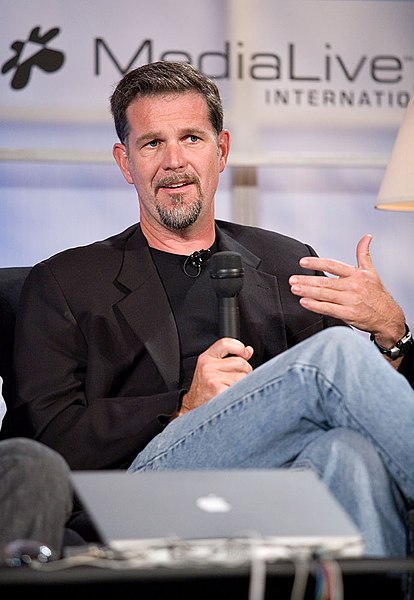Leading with Vision: The Reed Hastings Story of Disruptive Innovation and People-Centric Leadership

Pioneering a New Era: The Leadership Journey of Reed Hastings
Importance of leadership in driving organizational success
Leadership plays a pivotal role in the success of organizations across industries. Effective leaders have the ability to inspire and guide their teams towards a shared vision, driving innovation, growth, and adaptability. They possess a unique set of skills and qualities that enable them to navigate challenges, make strategic decisions, and create an environment conducive to high performance.
Brief introduction to Reed Hastings and his leadership journey
Reed Hastings is a prominent figure in the world of business and leadership, known for his transformative role in revolutionizing the entertainment industry. As the co-founder and CEO of Netflix, Hastings has been at the helm of one of the most successful and disruptive companies of our time. His leadership style and strategic decisions have shaped not only Netflix’s growth but also the way we consume entertainment in the digital age.
Reed Hastings’ leadership journey is a testament to the power of vision, innovation, and adaptability. He has navigated through the evolving landscape of the entertainment industry, overcoming obstacles and making bold decisions that have propelled Netflix to its current position as a global entertainment powerhouse.
Throughout his career, Hastings has demonstrated a keen understanding of the importance of staying ahead of the curve and embracing change. His leadership approach is marked by a commitment to fostering a culture of innovation, empowering employees, and making data-driven decisions. By examining his leadership lessons and stories, we can gain valuable insights into the principles and practices that have contributed to his success.
In the following sections of this article, we will delve into the various aspects of Reed Hastings’ leadership journey, exploring his background, pivotal moments in his career, and the lessons that can be gleaned from his experiences. From the founding of Netflix to leading through crisis and fostering a culture of innovation, we will uncover the leadership strategies and insights that have shaped Hastings’ remarkable trajectory.
By understanding the leadership principles and lessons that have guided Reed Hastings, leaders of all levels can gain valuable perspectives to enhance their own leadership skills. Whether you are a seasoned executive, an aspiring leader, or someone interested in the fascinating world of leadership, this article will provide you with a comprehensive exploration of the leadership journey of Reed Hastings and the lessons we can all learn from his remarkable story.
Background and Early Career
Overview of Reed Hastings’ background and early life
To understand Reed Hastings’ leadership journey, it is important to explore his background and early life. Born on October 8, 1960, in Boston, Massachusetts, Hastings grew up in a family that valued education and intellectual pursuits. His passion for learning and curiosity served as the foundation for his future endeavors.
Hastings attended Bowdoin College, where he earned a bachelor’s degree in mathematics. During his college years, he displayed a natural inclination towards leadership, serving as the president of his dormitory and involving himself in various campus activities. This early exposure to leadership roles laid the groundwork for his future endeavors.
Highlights of his professional career before founding Netflix
Following his graduation, Hastings began his professional career as a software engineer, working for companies such as Adaptive Technology and Chevron. It was during this time that he honed his technical skills and gained valuable industry experience.
In 1991, Hastings co-founded his first company, Pure Software, which focused on developing debugging software. Under his leadership, Pure Software experienced considerable success and went public in 1995. However, despite its initial triumphs, the company faced challenges due to integration issues with acquired companies. This experience taught Hastings important lessons about leadership, decision-making, and the complexities of managing growth.
Key experiences and lessons learned during this period
Reed Hastings’ early career was marked by pivotal experiences that shaped his leadership philosophy. As he transitioned from a software engineer to a business leader, he recognized the importance of embracing change, taking calculated risks, and continuously learning from both successes and failures.
One crucial lesson Hastings learned was the significance of maintaining a strong company culture. At Pure Software, he witnessed firsthand the challenges that can arise when cultures clash during mergers and acquisitions. This experience solidified his belief in the importance of nurturing a cohesive and values-driven culture.
Additionally, Hastings recognized the transformative power of disruptive innovation. His experiences at Pure Software and his observations of the rapidly changing technology landscape fueled his desire to create something truly groundbreaking.
Another valuable lesson Hastings gleaned from his early career was the importance of surrounding oneself with talented individuals. He understood that success is not solely dependent on individual brilliance but also on the collective efforts of a high-performing team. This realization would later influence his approach to talent acquisition and retention at Netflix.
Overall, the experiences and lessons Reed Hastings gained during his formative years laid a strong foundation for his future leadership endeavors. His exposure to diverse challenges, coupled with his innate passion for learning and growth, provided him with the insights and resilience necessary to navigate the uncertainties and complexities of entrepreneurship and leadership.
Founding Netflix: A Transformational Leader Emerges
The birth of Netflix and its initial focus
In the late 1990s, Reed Hastings experienced a moment that would shape the future of the entertainment industry. Frustrated by a late fee incurred from returning a rented DVD, he realized the potential for a business model that eliminated the inconvenience of physical video stores. This realization laid the foundation for the birth of Netflix.
In 1997, Hastings co-founded Netflix with Marc Randolph, initially positioning it as an online DVD rental service. The concept was simple yet revolutionary: instead of customers having to visit a brick-and-mortar store, they could order DVDs online and have them delivered to their doorsteps. This convenience and customer-centric approach set Netflix apart from traditional video rental businesses.
Reed Hastings’ vision for disrupting the traditional video rental industry
Reed Hastings’ vision extended beyond just the convenience of DVD rentals. He foresaw the potential for technology to reshape the entire entertainment landscape. Hastings believed that the future of media consumption would be digital, and he set out to position Netflix as a leader in this space.
Recognizing the limitations of physical DVDs, Hastings anticipated the eventual transition to online streaming. He saw the opportunity to leverage the internet to provide an expansive library of content that customers could access anytime, anywhere. This forward-thinking approach allowed Netflix to anticipate and capitalize on the evolving preferences of consumers.
Leadership strategies employed by Hastings during the early stages
During the early stages of Netflix, Reed Hastings employed several key leadership strategies that contributed to its growth and success. One of the most notable aspects of his leadership was his ability to articulate and communicate a clear vision. Hastings had a knack for conveying his passion for revolutionizing the entertainment industry and inspiring others to join him on this journey.
Moreover, he understood the importance of surrounding himself with a talented team that shared his vision. Hastings focused on hiring individuals who were not only skilled in their respective areas but also aligned with Netflix’s values and culture. By assembling a team of innovators and disruptors, he created a culture of excellence and collaboration that propelled Netflix forward.
Another critical aspect of Hastings’ leadership was his emphasis on data-driven decision-making. He recognized the value of using data and analytics to guide strategic choices, optimize operations, and personalize the user experience. This data-centric approach allowed Netflix to stay ahead of the competition and continuously improve its offerings.
Lessons learned from the challenges faced and decisions made during this period
The early years of Netflix were not without challenges. As the company transitioned from a DVD rental service to an online streaming platform, it faced significant obstacles. The shift required negotiating complex licensing agreements with content providers, managing technological infrastructure, and convincing customers to embrace streaming as the future of entertainment.
Through these challenges, Reed Hastings learned valuable lessons that shaped his leadership approach. He realized the importance of adaptability and agility in navigating rapidly changing industries. Hastings understood that leaders must be willing to embrace uncertainty, experiment, and pivot when necessary to stay relevant and competitive.
Additionally, Hastings recognized the need for continuous innovation and investment in technology. He understood that success in the digital age required staying ahead of emerging trends and constantly evolving to meet customer expectations. By embracing disruptive technologies and making bold investments, Netflix positioned itself as an industry leader.
In summary, the founding of Netflix under Reed Hastings’ leadership marked a pivotal moment in the entertainment industry. His vision for digital media consumption, coupled with his ability to inspire and lead, set the stage for Netflix’s remarkable trajectory. Through his strategic decisions, commitment to innovation, and lessons learned from challenges, Hastings emerged as a transformational leader, shaping not only the future of Netflix but also the entire entertainment landscape.
Navigating Change: The Transition to Streaming
The shift from DVD rentals to online streaming
Reed Hastings’ leadership journey took an extraordinary turn when he recognized the need to transition Netflix from a DVD rental service to an online streaming platform. This shift was driven by the changing landscape of media consumption and the increasing popularity of digital streaming among consumers. Hastings understood that to remain at the forefront of the industry, Netflix had to embrace this disruptive technology and capitalize on its potential.
The transition to streaming was not without its challenges. It required substantial investments in infrastructure, content licensing agreements, and technological advancements. However, Hastings’ leadership and strategic decisions played a pivotal role in guiding Netflix through this transformative period.
Challenges and opportunities presented by the streaming era
The streaming era presented both significant challenges and tremendous opportunities for Netflix. On one hand, the company faced intense competition from traditional media conglomerates and emerging streaming platforms. On the other hand, the shift to streaming offered unparalleled possibilities for growth, global reach, and personalization of content.
Hastings recognized the importance of differentiation and the need to provide a compelling value proposition to customers. Under his leadership, Netflix invested in original content production, securing exclusive distribution rights to critically acclaimed shows and movies. By offering a unique catalog of high-quality, original programming, Netflix positioned itself as a leader in the streaming industry and successfully differentiated its platform from competitors.
Moreover, the streaming era brought forth the opportunity for personalized recommendations and a user-centric experience. Hastings understood the power of data analytics and the ability to leverage user preferences to curate personalized content suggestions. This data-driven approach not only enhanced customer satisfaction but also helped Netflix gain valuable insights into consumer behavior, allowing the company to make informed strategic decisions.
Leadership approaches utilized by Hastings to drive Netflix’s success in the new landscape
Reed Hastings employed several key leadership approaches to drive Netflix’s success in the streaming era. Firstly, he fostered a culture of innovation and experimentation within the company. Hastings encouraged employees to think creatively, take risks, and challenge the status quo. This approach empowered teams to develop groundbreaking ideas and drive continuous improvement.
Additionally, Hastings embraced a customer-centric mindset. He recognized the importance of understanding and meeting the evolving needs of consumers. By prioritizing customer satisfaction and constantly refining the user experience, Netflix built a loyal and engaged user base.
Furthermore, Hastings emphasized the importance of agility and adaptability in leadership. He understood that in a rapidly evolving industry, it was essential to be nimble and responsive to changes in consumer preferences and technological advancements. Netflix’s ability to pivot quickly and embrace emerging trends, such as the shift towards mobile and smart TVs, showcased Hastings’ leadership in navigating change.
Case studies and stories highlighting key leadership lessons during this period
Several case studies and stories from Netflix’s journey in the streaming era exemplify key leadership lessons under Reed Hastings’ guidance. One such example is the successful foray into original content production. By investing in shows like “House of Cards” and “Stranger Things,” Hastings showcased the power of taking calculated risks and pushing boundaries.
Another notable case study is the international expansion of Netflix. Under Hastings’ leadership, Netflix expanded its footprint globally, overcoming challenges related to licensing, cultural differences, and infrastructure. The company’s international success demonstrated the importance of embracing diverse markets and tailoring strategies to suit specific regions.
Furthermore, the decision to separate Netflix’s DVD-by-mail service and streaming service, known as the Qwikster debacle, offers valuable lessons in humility and transparency. After facing backlash from customers and realizing the mistake, Hastings publicly acknowledged the misstep and quickly reversed the decision. This incident highlighted the significance of listening to customer feedback, admitting mistakes, and course-correcting.
In summary, Reed Hastings’ leadership during the transition to streaming was characterized by a combination of visionary thinking, strategic decision-making, and a focus on customer-centricity. By recognizing the potential of streaming and embracing the challenges it presented, Hastings led Netflix to become a dominant force in the entertainment industry.
Through his leadership approaches, Hastings instilled a culture of innovation and experimentation, encouraging employees to push boundaries and think outside the box. This fostered an environment where groundbreaking ideas flourished, leading to the development of award-winning original content and technological advancements.
Hastings’ customer-centric mindset played a crucial role in Netflix’s success. By understanding and meeting the evolving needs of consumers, he ensured that the platform remained engaging, intuitive, and personalized. This commitment to customer satisfaction not only attracted and retained subscribers but also provided valuable insights into consumer behavior, enabling data-driven decision-making.
The streaming era also required Hastings to lead with agility and adaptability. He understood the importance of staying ahead of emerging trends and technological advancements, allowing Netflix to pivot quickly and embrace new opportunities. From expanding internationally to embracing new devices and platforms, Hastings’ leadership ensured that Netflix remained at the forefront of innovation.
The stories and case studies from this period provide invaluable leadership lessons. They emphasize the significance of taking calculated risks, being responsive to customer feedback, admitting and learning from mistakes, and fostering a culture that encourages innovation and collaboration. Through these experiences, Hastings exemplified the qualities of a transformational leader who could navigate complex challenges and drive success in a rapidly evolving industry.
Reed Hastings’ leadership during the transition to streaming propelled Netflix to become a global entertainment powerhouse. His strategic vision, customer-centric focus, and ability to navigate change with agility and adaptability set the stage for Netflix’s continued growth and dominance. The leadership lessons derived from this era offer valuable insights for leaders across industries, emphasizing the importance of innovation, customer-centricity, and a willingness to embrace change. As we continue to witness the evolution of the entertainment landscape, Reed Hastings’ leadership journey serves as a remarkable example of how visionary leadership can shape an entire industry.
A Culture of Innovation and Bold Decision-Making
The importance of fostering a culture of innovation
One of the defining characteristics of Reed Hastings’ leadership at Netflix is his unwavering commitment to fostering a culture of innovation. Hastings understood that in a rapidly changing industry, maintaining a competitive edge required a relentless pursuit of new ideas and creative solutions. He believed that innovation should permeate every aspect of the organization, from product development to customer experience.
To cultivate a culture of innovation, Hastings encouraged employees to think critically, challenge assumptions, and take risks. He created an environment where ideas were welcomed, regardless of hierarchy or departmental boundaries. By fostering a sense of psychological safety and open communication, Hastings empowered employees to share their perspectives and experiment with new approaches.
Netflix’s famous “Culture Deck,” a document that outlines the company’s values and guiding principles, played a crucial role in nurturing an innovative culture. It emphasized freedom and responsibility, encouraging employees to take ownership of their work and make decisions based on data and insights. This autonomy and trust empowered individuals to think creatively, contributing to the constant stream of innovative ideas that have driven Netflix’s success.
Reed Hastings’ emphasis on empowering employees and encouraging creativity
Reed Hastings recognized that true innovation comes from the collective intelligence and diverse perspectives of the workforce. He believed in empowering employees and creating an environment where they could thrive creatively. Hastings understood that great ideas could come from anyone, regardless of their role or seniority.
At Netflix, employees are encouraged to take initiative and make decisions independently. Hastings championed the notion of empowering individuals and trusting them to make the right choices. This approach not only fostered a sense of ownership but also enabled faster decision-making and more efficient execution.
Hastings also understood the importance of embracing diversity and inclusion in driving innovation. He recognized that diverse teams bring different experiences, ideas, and approaches to the table, leading to richer and more innovative solutions. By actively promoting diversity and inclusion, both within the company and in the content produced, Hastings ensured that Netflix remained relevant and appealing to a wide range of audiences.
Examples of bold decisions made by Hastings and their impact on Netflix’s growth
Bold decision-making has been a hallmark of Reed Hastings’ leadership at Netflix. He has consistently made decisions that have pushed the boundaries of the industry and propelled the company’s growth. These decisions have been instrumental in positioning Netflix as a disruptor and market leader.
One notable example is the decision to invest heavily in original content production. In an industry dominated by established studios and networks, Hastings took a bold leap by committing substantial resources to develop high-quality, original programming. This move allowed Netflix to differentiate itself from competitors and attract subscribers with exclusive content that couldn’t be found elsewhere. The success of shows like “House of Cards,” “Stranger Things,” and “The Crown” not only cemented Netflix’s reputation for producing critically acclaimed content but also showcased Hastings’ bold vision for the future of entertainment.
Another bold decision was Netflix’s move to shift from a content aggregator to a content creator. Hastings recognized the long-term risks of relying solely on licensing agreements with other studios and networks. By developing its own intellectual property and building a library of original content, Netflix gained greater control over its offerings and reduced dependence on external sources. This strategic shift has paid off immensely, with Netflix now recognized as a major player in content creation, securing its position as a leading global entertainment provider.
Lessons on risk-taking, experimentation, and adaptation in leadership
Reed Hastings’ emphasis on risk-taking, experimentation, and adaptation offers valuable leadership lessons for aspiring leaders. One of the key takeaways is the importance of embracing calculated risks. Hastings understood that innovation often involves venturing into uncharted territory and taking risks that others may shy away from. By taking calculated risks, leaders can unlock new opportunities and drive growth.
Furthermore, Hastings demonstrated the value of experimentation. He encouraged teams to test hypotheses, iterate quickly, and learn from failures. This iterative approach allowed Netflix to continuously refine its offerings and stay ahead of the competition. Hastings understood that not every experiment would be successful, but he fostered a culture where failures were seen as valuable learning experiences rather than setbacks.
Adaptability was another critical leadership lesson exemplified by Hastings. He recognized that in a dynamic industry like entertainment, leaders must be willing to adapt to changing market trends and consumer preferences. Whether it was embracing the shift to streaming or responding to the rise of mobile viewing, Hastings consistently led Netflix in adapting its strategies and operations to stay relevant and capitalize on emerging opportunities.
By embracing risk-taking, encouraging experimentation, and fostering adaptability, leaders can create an environment where innovation thrives. Hastings’ leadership approach at Netflix serves as a powerful example of how a culture of innovation and bold decision-making can drive success in a rapidly evolving industry.
Reed Hastings’ leadership at Netflix has been defined by a culture of innovation, empowerment, and bold decision-making. By fostering an environment that encourages creativity, empowering employees, and taking calculated risks, Hastings has enabled Netflix to become a leader in the entertainment industry. His emphasis on experimentation and adaptability has allowed Netflix to stay ahead of the curve and consistently deliver innovative solutions to its customers. The leadership lessons derived from Hastings’ approach provide valuable insights for leaders seeking to drive innovation, inspire their teams, and navigate dynamic and disruptive markets.
Leading Through Crisis: The Qwikster Debacle
Overview of the Qwikster crisis and its impact on Netflix
No leadership journey is without its moments of crisis, and Reed Hastings’ tenure at Netflix was no exception. One such pivotal moment was the Qwikster debacle in 2011, which significantly impacted Netflix and tested Hastings’ leadership abilities. The crisis arose when Netflix announced a plan to split its DVD-by-mail service from its streaming service, rebranding the DVD service as Qwikster. This decision was met with widespread backlash from customers and investors, leading to a significant decline in Netflix’s stock price and a loss of subscribers.
Reed Hastings’ response to the crisis and his leadership during challenging times
In the face of this crisis, Reed Hastings demonstrated his ability to lead with humility, transparency, and resilience. Rather than deflecting blame or downplaying the severity of the situation, Hastings took full responsibility for the misstep. He publicly acknowledged the mistakes made in communication and decision-making, offering a sincere apology to Netflix’s customers and stakeholders.
Hastings recognized the importance of rebuilding trust and making amends. In a decisive move, he swiftly reversed the decision to split the services and rebranded the DVD service as a part of Netflix, abandoning the Qwikster brand altogether. By listening to customer feedback and taking immediate action, Hastings demonstrated his commitment to rectifying the situation and putting the interests of Netflix’s subscribers first.
Throughout the crisis, Hastings maintained open lines of communication, providing regular updates and engaging in transparent conversations with employees, customers, and investors. He recognized that clear and honest communication was essential in regaining trust and aligning stakeholders behind the company’s vision.
Lessons learned about humility, transparency, and resilience in leadership
The Qwikster crisis offered valuable leadership lessons, highlighting the importance of humility, transparency, and resilience in times of adversity. Hastings’ response serves as a powerful example of leadership accountability and the willingness to learn from mistakes.
Humility played a central role in Hastings’ response. By acknowledging the missteps and taking responsibility for the situation, he demonstrated that leaders must be willing to admit their faults and learn from them. This humility not only earned respect but also set the stage for the rebuilding of trust and confidence.
Transparency was another key lesson derived from Hastings’ leadership during the crisis. By openly addressing the concerns and providing transparent updates, he fostered an environment of trust and reassured stakeholders that their voices were heard. Transparency not only helped in the immediate aftermath of the crisis but also laid the foundation for a stronger and more transparent organizational culture moving forward.
Resilience was also exemplified by Hastings’ ability to weather the storm and guide Netflix through the challenging times. Instead of being consumed by the crisis, he remained focused on the long-term vision and the steps necessary to rebuild the company’s reputation. His resilience allowed Netflix to bounce back and continue its trajectory of growth and innovation.
Leaders facing crises can draw several lessons from Hastings’ experience. They must be willing to acknowledge mistakes, take swift and decisive action, communicate transparently, and demonstrate resilience in the face of adversity. The Qwikster crisis underscored the significance of leading with humility, transparency, and resilience, ultimately strengthening Reed Hastings’ leadership and paving the way for Netflix’s continued success.
The Qwikster debacle was a defining moment in Reed Hastings’ leadership journey at Netflix. Through his response to the crisis, he demonstrated the importance of humility, transparency, and resilience in leadership. By learning from mistakes, taking accountability, and maintaining open lines of communication, Hastings successfully navigated a challenging period and reaffirmed his commitment to the values that have shaped Netflix’s culture. The lessons derived from this experience provide invaluable insights for leaders facing crises and highlight the importance of effective leadership during challenging times.
Moreover, the Qwikster crisis showcased the importance of stakeholder management. Hastings recognized the impact of the crisis on various stakeholders, including employees, customers, and investors. By prioritizing transparent and empathetic communication, he was able to rebuild trust and maintain strong relationships with these key stakeholders. This emphasized the significance of considering the needs and concerns of all stakeholders and aligning their interests with the organization’s goals.
Additionally, the crisis underscored the value of resilience in leadership. Hastings faced immense pressure and scrutiny during this challenging period, but he remained steadfast in his commitment to navigate the crisis and steer Netflix back on track. His ability to stay resilient and lead with conviction set an example for his team and instilled confidence in the organization’s ability to overcome adversity.
The Qwikster crisis ultimately served as a catalyst for growth and transformation at Netflix. It forced the company to reflect on its strategies, decision-making processes, and communication practices. Netflix emerged from the crisis with a renewed focus on customer satisfaction, clearer communication channels, and a stronger commitment to delivering innovative and high-quality content.
The lessons learned from the Qwikster crisis extend beyond Netflix and hold relevance for leaders in all industries. They emphasize the need for leaders to approach crises with humility, transparency, and resilience. By acknowledging mistakes, learning from them, and taking decisive action, leaders can not only mitigate the impact of crises but also build stronger organizations that are better prepared to face future challenges.
Reed Hastings’ leadership during the Qwikster crisis demonstrated the significance of humility, transparency, and resilience in guiding organizations through challenging times. The crisis served as a valuable learning experience, highlighting the importance of stakeholder management, open communication, and the ability to withstand pressure. By drawing upon the lessons derived from this period, leaders can strengthen their own leadership capabilities and navigate crises with confidence, ultimately paving the way for long-term success and organizational growth.
People-Centric Leadership: Developing and Retaining Top Talent
Reed Hastings’ approach to building and nurturing a talented workforce
In addition to his strategic vision and innovative thinking, Reed Hastings recognized the critical role that a talented and motivated workforce plays in the success of an organization. He placed a strong emphasis on people-centric leadership, focusing on attracting, developing, and retaining top talent at Netflix.
Hastings believed that hiring the right people was crucial to building a high-performing team. He prioritized hiring individuals who not only possessed the necessary skills and expertise but also aligned with Netflix’s culture and values. This emphasis on cultural fit ensured that employees shared a common sense of purpose and contributed to a cohesive organizational culture.
Moreover, Hastings valued diversity in his workforce. He understood the importance of having a team with diverse backgrounds, perspectives, and experiences. By embracing diversity and inclusion, Netflix was able to foster innovation, creativity, and better decision-making.
Strategies for attracting, developing, and retaining top talent
Attracting top talent was a priority for Reed Hastings, and he employed several strategies to attract the best individuals to Netflix. One key strategy was offering a dynamic and inclusive work environment. Hastings believed in creating a workplace culture that encouraged collaboration, learning, and personal growth. By providing opportunities for employees to make a meaningful impact, Netflix became an attractive destination for top talent seeking challenging and fulfilling careers.
In terms of talent development, Hastings championed a culture of continuous learning. He encouraged employees to take ownership of their professional growth and provided resources and support for their development. Netflix implemented innovative learning programs and offered generous benefits such as unlimited vacation time and flexible work arrangements, signaling its commitment to employee well-being and work-life balance.
Retaining top talent was another area of focus for Hastings. He recognized the importance of providing opportunities for career advancement, challenging assignments, and competitive compensation packages. By fostering a culture that recognized and rewarded exceptional performance, Netflix created an environment where employees felt valued and motivated to stay and grow within the organization.
Case studies and anecdotes showcasing effective people-centric leadership practices
Numerous case studies and anecdotes from Netflix’s journey highlight the effective people-centric leadership practices employed by Reed Hastings. One notable example is the “Keeper Test,” a practice where managers are asked to evaluate whether they would fight to keep a particular employee. This practice ensures that only the highest performers are retained and that underperformers are not allowed to hinder the overall team’s success.
Another example is the emphasis on radical candor and feedback. Hastings believed in creating a culture where open and honest communication thrived. This included providing constructive feedback and fostering an environment where employees felt comfortable challenging ideas and voicing their opinions. This practice encouraged continuous improvement and helped individuals and teams reach their full potential.
Furthermore, the famous Netflix culture document, often referred to as the “Netflix Culture Deck,” provided a blueprint for effective people management. The document outlined the company’s expectations, values, and behaviors, setting clear guidelines for employees to align their actions with the organizational culture. It served as a powerful tool for attracting and retaining top talent who resonated with Netflix’s unique approach to leadership.
Reed Hastings’ people-centric leadership approach fostered a culture of excellence, collaboration, and continuous growth at Netflix. By prioritizing cultural fit, diversity, talent development, and employee engagement, Hastings created an environment where top talent thrived and contributed to the organization’s success. The case studies and anecdotes from Netflix’s journey provide valuable insights into effective people-centric leadership practices that can be applied in diverse industries, inspiring leaders to prioritize their workforce and unleash the full potential of their teams.
The Power of Continuous Learning and Adaptation
Reed Hastings’ commitment to personal and professional growth
Reed Hastings’ leadership journey is marked by his unwavering commitment to continuous learning and personal growth. He understood that effective leaders must be willing to adapt, evolve, and expand their knowledge and skills. Hastings himself exemplified this commitment by continually seeking opportunities for learning and self-improvement.
Throughout his career, Hastings immersed himself in books, industry research, and conversations with thought leaders. He actively sought out new perspectives and diverse viewpoints to broaden his understanding of the business landscape. This dedication to continuous learning not only sharpened his own leadership acumen but also enabled him to navigate the dynamic and ever-changing entertainment industry.
The importance of fostering a learning culture within organizations
Recognizing the value of continuous learning, Hastings emphasized the importance of fostering a learning culture within Netflix. He understood that organizations that prioritize learning and development are better equipped to adapt to new challenges, seize opportunities, and stay ahead of the competition.
At Netflix, learning was not limited to formal training programs. Hastings encouraged a culture of curiosity, where employees were encouraged to experiment, take risks, and learn from both successes and failures. He promoted a growth mindset, where individuals were empowered to embrace challenges, seek feedback, and continually improve their skills.
To foster a learning culture, Hastings encouraged knowledge-sharing and collaboration. He established platforms and channels for employees to exchange ideas, share best practices, and learn from one another. This emphasis on collective learning and collaboration not only accelerated individual growth but also fostered a sense of camaraderie and collective intelligence within the organization.
Lessons on adaptability, open-mindedness, and embracing change in leadership
One of the key lessons derived from Reed Hastings’ leadership is the importance of adaptability and open-mindedness. Hastings recognized that in a rapidly evolving industry, leaders must be willing to adapt their strategies, embrace change, and challenge conventional thinking. By fostering an environment that embraced change and encouraged new ideas, Hastings enabled Netflix to respond quickly to emerging trends and capitalize on new opportunities.
Moreover, Hastings understood that leaders must be open to feedback and willing to challenge their own assumptions. He encouraged a culture where constructive criticism was valued, and differing viewpoints were welcomed. This approach not only fostered innovation but also created a culture of continuous improvement, where leaders and employees alike were encouraged to question the status quo and seek better ways of doing things.
Hastings also demonstrated the importance of being proactive rather than reactive. He understood that leaders must anticipate change and proactively adapt their strategies and operations to stay ahead. This proactive approach allowed Netflix to anticipate shifts in consumer behavior, technological advancements, and market dynamics, enabling the company to innovate and maintain its competitive edge.
Reed Hastings’ commitment to continuous learning and adaptation underscores the significance of ongoing personal and professional growth in leadership. By fostering a learning culture, embracing change, and encouraging open-mindedness, leaders can navigate complexities, seize opportunities, and lead their organizations towards success in an ever-changing world. The lessons derived from Hastings’ approach serve as a reminder that learning is a lifelong journey and that adaptability is a key characteristic of effective leadership in the face of constant change.
Legacy and Influence: Reed Hastings’ Impact on Leadership Development
Reed Hastings as a thought leader and influencer in the field of leadership
Reed Hastings’ leadership journey and his transformative impact on Netflix have positioned him as a thought leader and influencer in the field of leadership development. His innovative strategies, bold decision-making, and emphasis on a people-centric culture have garnered attention and admiration from leaders across industries. Hastings’ insights and practices have not only shaped Netflix’s success but have also left a lasting legacy in the realm of leadership.
Disruptive leadership and the Netflix effect
Hastings’ approach to leadership can be described as disruptive, as he challenged traditional models and norms within the entertainment industry. The success of Netflix under his guidance has been referred to as the “Netflix effect,” highlighting the impact of disruptive leadership on established industries. Hastings’ ability to identify and capitalize on emerging trends, coupled with his commitment to innovation and customer-centricity, has inspired leaders to question the status quo and embrace change as a driver of success.
Lessons from Hastings’ leadership journey for aspiring leaders
Reed Hastings’ leadership journey offers valuable lessons for aspiring leaders seeking to make their mark in the business world. One key lesson is the importance of having a clear vision and a willingness to take risks. Hastings’ visionary thinking and his ability to make bold decisions in the face of uncertainty propelled Netflix to its current position of prominence. Aspiring leaders can learn from his example by cultivating their own vision and embracing calculated risks to drive innovation and growth.
Another lesson derived from Hastings’ leadership is the significance of fostering a culture of innovation and adaptability. His emphasis on continuous learning, experimentation, and adaptation has shown the power of a dynamic and agile organizational culture. Aspiring leaders can draw inspiration from Hastings by creating environments that encourage creativity, open communication, and the pursuit of excellence.
Furthermore, Hastings’ people-centric approach to leadership highlights the importance of attracting, developing, and retaining top talent. His focus on cultural fit, diversity, and talent development has enabled Netflix to build a high-performing team and nurture a culture of excellence. Aspiring leaders can emulate Hastings’ approach by prioritizing their workforce, valuing diverse perspectives, and investing in employee growth and development.
Reed Hastings’ contribution to the leadership development landscape
Reed Hastings’ impact extends beyond the success of Netflix; he has made significant contributions to the leadership development landscape. Through his thought leadership, speaking engagements, and the sharing of his experiences, Hastings has influenced leaders around the world. His insights into disruptive leadership, innovation, and talent management have become valuable resources for individuals seeking to enhance their own leadership skills.
Furthermore, the Netflix culture document, often referred to as the “Netflix Culture Deck,” has become a source of inspiration for many organizations. Hastings’ transparency in sharing Netflix’s values and guiding principles has sparked conversations about organizational culture, employee empowerment, and the future of work. Leaders have taken cues from the Netflix culture document to shape their own organizational cultures and drive positive change within their respective companies.
Reed Hastings’ impact on leadership development is far-reaching. His disruptive leadership approach, emphasis on innovation and adaptability, people-centricity, and commitment to continuous learning have left an indelible mark on the business world. Aspiring leaders can draw valuable lessons from his journey and apply them to their own leadership endeavors, while the broader leadership community continues to benefit from his thought leadership and contributions to the field. Reed Hastings’ influence as a leadership icon is a testament to the enduring legacy he has created through his exceptional leadership journey.
Shaping the Future: Reed Hastings’ Enduring Legacy in Leadership Developmen
Reed Hastings’ leadership journey at Netflix serves as a remarkable case study in visionary thinking, disruptive innovation, and people-centric leadership. His ability to anticipate industry shifts, embrace change, and cultivate a culture of excellence has propelled Netflix to become a global entertainment powerhouse. Hastings’ impact extends beyond Netflix, as his leadership principles and insights have influenced leaders across industries and left a lasting legacy in the field of leadership development.
Throughout his career, Hastings has exemplified the qualities of a transformational leader. His strategic decisions, such as the shift to streaming and the investment in original content, have not only revolutionized the entertainment industry but have also redefined consumer behavior and expectations. By challenging traditional models and embracing disruptive technologies, Hastings has left an indelible mark on the way we consume and experience media.
One of the key pillars of Hastings’ leadership approach is a relentless commitment to innovation. He has fostered a culture where experimentation, calculated risk-taking, and continuous learning are celebrated. By nurturing an environment that encourages creativity and embraces failure as an opportunity for growth, Hastings has empowered his teams to push boundaries and drive groundbreaking ideas. This focus on innovation has not only fueled Netflix’s success but has also inspired leaders to challenge the status quo and embrace disruptive thinking in their own organizations.
Another hallmark of Hastings’ leadership is his people-centric approach. He recognizes that an organization’s success is built on the collective efforts of a talented and motivated workforce. By prioritizing cultural fit, diversity, and talent development, Hastings has created an environment where employees feel empowered, valued, and motivated to contribute their best work. His emphasis on attracting, developing, and retaining top talent has become a benchmark for organizations seeking to build high-performing teams and foster a culture of excellence.
Reed Hastings’ leadership journey also showcases his ability to navigate challenges and crises with humility, transparency, and resilience. The Qwikster debacle served as a pivotal moment in his career, demonstrating his willingness to take accountability, learn from mistakes, and rebuild trust. His response to the crisis offers valuable lessons for leaders facing adversity, emphasizing the importance of open communication, swift action, and a commitment to rectifying mistakes.
As a thought leader and influencer, Reed Hastings has shaped the leadership development landscape. His insights into disruptive leadership, innovation, and talent management have provided inspiration and guidance to leaders worldwide. The Netflix culture document, in particular, has become a source of inspiration for organizations seeking to cultivate a strong organizational culture, empower their employees, and drive positive change.
In conclusion, Reed Hastings’ leadership journey at Netflix exemplifies the qualities of a visionary and transformative leader. His commitment to innovation, people-centricity, continuous learning, and adaptability has not only propelled Netflix to remarkable heights but has also left a lasting impact on the field of leadership development. Aspiring leaders can draw valuable lessons from his journey, while the broader leadership community continues to benefit from his thought leadership and contributions to the field. Reed Hastings’ enduring legacy as a visionary leader and influencer will continue to shape the future of leadership for years to come.





